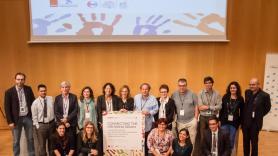3. Models and treatments: the search for solutions
Biomedical research is complex in itself, but studying what are known as synaptic diseases adds additional difficulties. On one hand, because many of the genes involved have pleiotropic effects, meaning that altering them can lead to different effects. And these effects, moreover, can overlap across different syndromes. And, on the other, because in general they are rare diseases, which makes it more difficult to do patient research. This is why “we need animal models,” says Soledad Alcántara, professor in the Department of Pathology at the University of Barcelona.
These models are generally mice, and they have their own difficulties. Their genetic makeup, obviously, isn't the same as that of humans and there are many factors that may “confuse” the results. This is why up to 80% of treatments that work on models may not work on patients. But advancing towards better understanding the mechanisms of the disease seems to be the only way forward. “Pharmaceutical companies have abandoned neuroscience,” says Mara Dierssen, group leader at the Center for Genomic Regulation in Barcelona (CRG). In part this is “because mistakes have been made, like basing treatment on symptoms. It must be based on physiopathology, on the mechanisms of the disease.”
Dierssen’s main line of research concerns Down syndrome. Based on the idea of attacking the mechanisms, her group began to test a compound found in green tea that seems to reverse some of the symptoms. The compound wasn’t chosen by chance: it is an inhibitor of the Dyrk1 protein, which in excess causes effects similar to Down syndrome in mice. The compound is undergoing clinical trials and, according to Dierssen, “seems to improve various aspects, including cognitive function.” Even neuroimaging studies “indicate improved brain activity and connectivity.”
Drugs are one treatment option, but in the case of genetic diseases, another may be gene therapy, treatments aimed at correcting or compensating for defective genes. In the case of neuropediatric diseases, according to Dierssen, most research focuses on Leber's congenital amaurosis, a disease of the retina that tends to cause congenital blindness. The problem with these therapies is that the new genes normally have to be administered through a virus, which can enter anywhere in the genome and cause it to malfunction. But new techniques based on CRISPR technology will hopefully overcome these difficulties.
There are even some seemingly futuristic options, like controlling neuronal activity with light. This is the goal of disciplines like optogenetics and optopharmacology. The former uses gene therapy to introduce genes normally from algae into the neurons and then control their activation or inhibition with blue or yellow light, respectively. Optopharmacology, if possible, goes even further. As Pau Gorostiza, ICREA professor at the Institute for Bioengineering of Catalonia (IBEC), explained, it consists of “using synthetic compounds that join with endogenous proteins in the body in a reversible manner.” These compounds are normally derived from azobenzene, a molecule that folds when hit with light of different wavelengths. As they are found in specific proteins, they can be modulated with light and directed towards specific neurons. This will not only help study their function but also “has therapeutic potential,” says Gorostiza. For example, in better controlling neuronal activity, they could replace and improve the electro-stimulation therapies used for Parkinson and some serious cases of depression. Some even hope that they may be used for some types of autism like Rett syndrome, which is a serious disorder that affects girls and is due to a mutation in one gene. Experiments with mice involving electric stimulation have been able to lessen the symptoms of this condition, and Gorostiza doesn’t doubt in saying that these treatments “may end up being replaced by light-activated drugs.”



